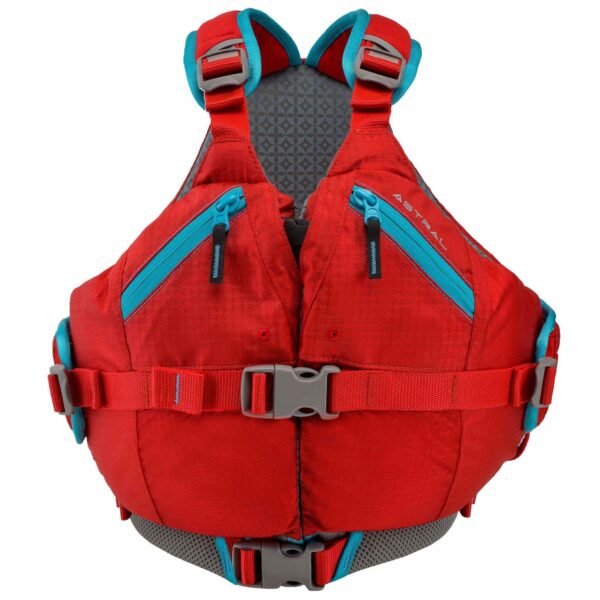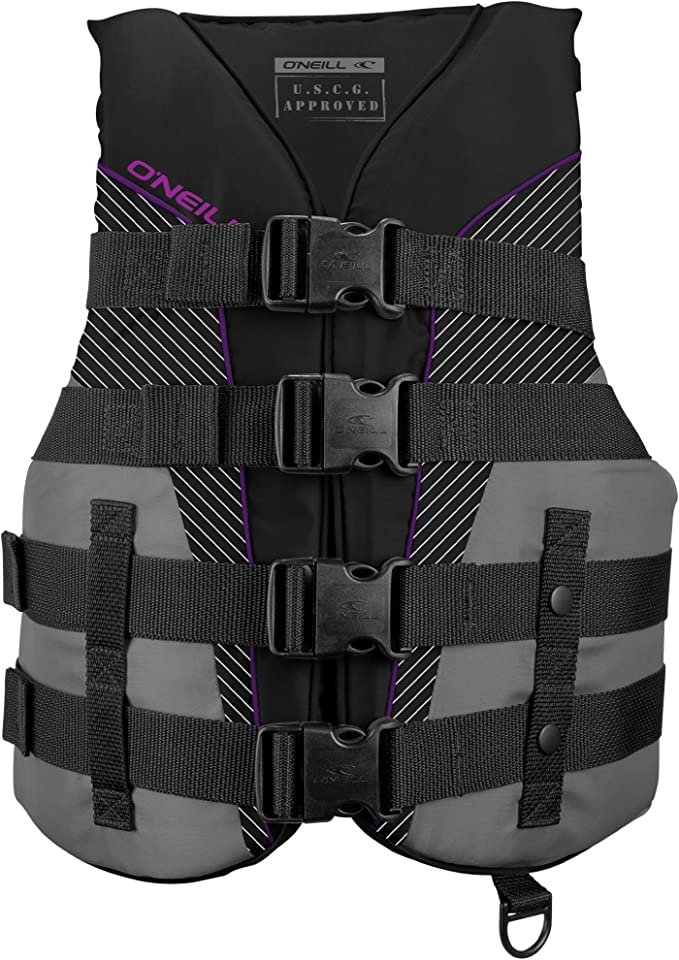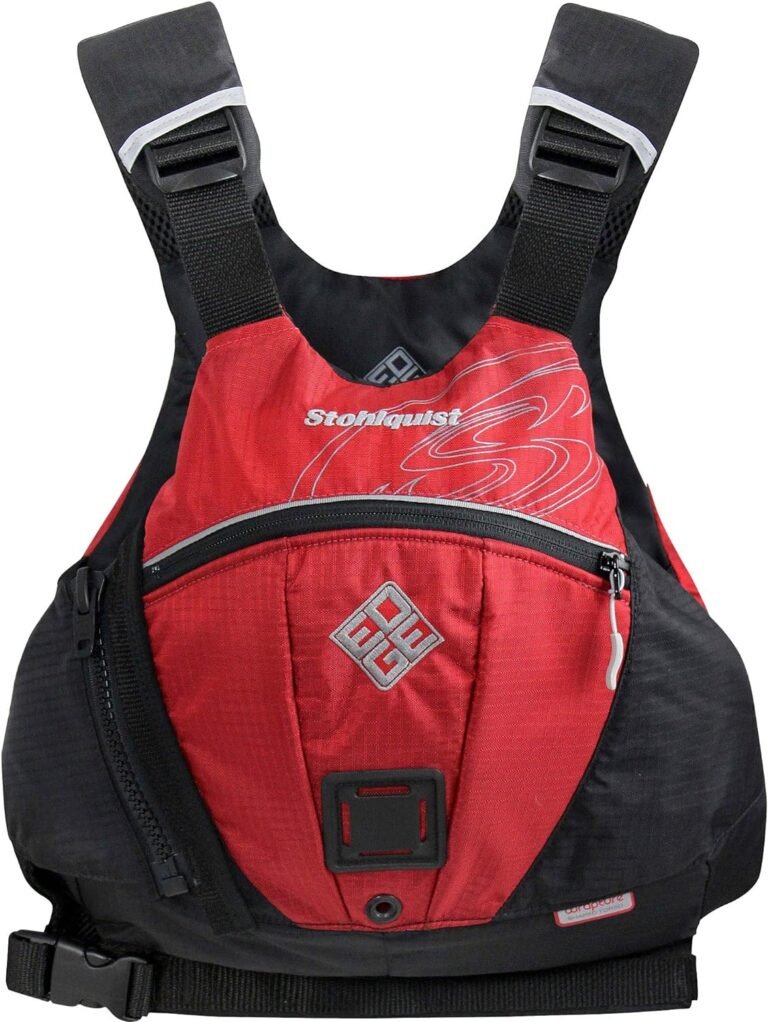Che cosa causa l'usura di un giubbotto salvagente nel tempo?

Il PFD (Personal Flotation Device), noto anche come giubbotto di salvataggio, è un equipaggiamento salvavita per le persone bloccate in acqua. Il dispositivo aiuta a mantenere l'utente a galla e al sicuro mentre attende i soccorsi.
Nel corso del tempo, tuttavia, un giubbotto salvagente può usurarsi e alla fine potrebbe non riuscire a proteggere chi lo indossa in caso di emergenza. In questo articolo, trattiamo le cause dell'usura dei giubbotti di salvataggio e come prenderti cura della tua attrezzatura.
Quali sono le funzioni e i vantaggi dei PFD?
I giubbotti di salvataggio sono importanti apparecchiature di sicurezza per i diportisti. Ci proteggono dagli elementi e possono aiutarci a salvarci la vita se ci troviamo in una situazione pericolosa incidente in barca. I giubbetti di salvataggio hanno diverse funzioni e vantaggi che li rendono essenziali per una navigazione sicura.
- Protezione dagli elementi
- Dispositivo di galleggiamento
- Isolamento termico
- Galleggiabilità e stabilità
- Navigazione
Perché è importante un salvagente su una moto d'acqua?
Un dispositivo di galleggiamento personale è importante su qualsiasi moto d'acqua perché può salvare la vita di una persona in caso di collasso.
I giubbotti salvagente dovrebbero essere indossati da chiunque si trovi a bordo di una barca, indipendentemente dal loro livello di esperienza, e dovrebbero essere sempre controllati prima dell'imbarco.
Oltre a salvare vite umane, indossare un giubbotto salvagente può anche ridurre la gravità delle lesioni in caso di ribaltamento. Possono essere utilizzati come a giubbotto di salvataggio per tenere a galla qualcuno se cade in mare. Una persona può perdere conoscenza se viene immersa nell'acqua e non indossa un giubbetto di salvataggio.
Come si consumano i PFD nel tempo?
I giubbotti di salvataggio sono importanti dispositivi di sicurezza per i diportisti e i partecipanti agli sport acquatici, ma possono anche usurarsi nel tempo. La durata di un giubbetto di salvataggio dipende da una serie di fattori, tra cui il tipo di giubbotto di salvataggio e il modo in cui viene utilizzato.
I giubbotti di salvataggio si consumano nel tempo a causa dei raggi UV del sole e dell'acqua salata. Il tessuto sbiadirà e le cinghie si romperanno. La causa più comune di usura del giubbotto salvagente è l'immersione.
Con il passare del tempo, il tessuto e la schiuma all'interno del giubbotto salvagente si satureranno d'acqua, rendendolo pesante e difficile da nuotare.
Quali sono i segnali che indicano che il tuo giubbotto di salvataggio deve essere sostituito?
Se sei mai stato in acqua e ti sei sentito come se stessi annegando, allora lo sai giubbotti di salvataggio sono essenziali. Questi piccoli capi di abbigliamento possono salvarti la vita in diverse situazioni imprevedibili.
Tuttavia, se il tuo giubbotto di salvataggio non è montato correttamente o se è danneggiato, potrebbe non fornire la protezione necessaria. Ecco cinque segnali che indicano che potrebbe essere necessario sostituire il giubbotto di salvataggio:
- Ti senti come se stessi costantemente lottando per rimanere a galla. Il giubbotto di salvataggio non sembra fornire una galleggiabilità adeguata.
- sono trascorsi più di 5 anni dall'ultima sostituzione del giubbotto di salvataggio.
- Hai perso peso e il giubbotto di salvataggio ormai è troppo grande. Il giubbotto di salvataggio non ti sta bene.
- Il giubbotto di salvataggio è stato danneggiato, è strappato e in cattive condizioni.
- è difficile gonfiare il giubbotto di salvataggio
Cause di usura del PFD
- Radiazione UV
- Umidità e umidità
- Alte temperature
- Strappi o danni al tessuto dovuti allo sfregamento contro altri oggetti nell'imbarcazione.
- L'esposizione all'acqua salata e al cloro può causare il deterioramento del tessuto.
- Danni alla cerniera principale dovuti allo sfregamento contro altri oggetti nella barca.
- I detriti rimangono intrappolati nella cerniera.
- Cerniere danneggiate a causa dell'uso di un coltello affilato o di altri strumenti affilati.
- Uso eccessivo
- Scarsa manutenzione
- Utilizzo sbagliato
- Usura normale
Tipi di dispositivi di galleggiamento personali
Esistono molti tipi di dispositivi di galleggiamento personali. Questi variano a seconda dello scopo per cui vengono utilizzati, se sono per uso ricreativo o commerciale, e dal tipo di materiali che li rendono galleggianti.
Alcuni tipi comuni di giubbotti di salvataggio includono giubbotti di salvataggio, zattere gonfiabili e galleggianti personali. Ognuno ha i suoi vantaggi e svantaggi, quindi è importante scegliere quello più adatto alle proprie esigenze.
1. Giubbotto salvagente di tipo I
Questi sono anche conosciuti come giubbotti di salvataggio offshore. I giubbotti di salvataggio di tipo I sono spesso il primo pezzo di equipaggiamento che un marinaio acquista, e per una buona ragione. Sono affidabili, compatti e facili da usare. Ma come ogni attrezzo, possono essere pericolosi se usati in modo errato.
2. Giubbotto salvagente di tipo II
Il PFD di tipo II, chiamato anche Near-Shore Buoyant Vest, è un tipo di dispositivo di galleggiamento personale (PFD) progettato per fornire assistenza al galleggiamento in caso di un'onda improvvisa o di un cambiamento di corrente.
Di solito viene indossato intorno alla vita e presenta una cintura in neoprene e spallacci. È simile a un giubbotto di salvataggio, ma ha più tasche e scomparti per riporre gli oggetti.
Il giubbotto salvagente di tipo II può essere indossato in molti modi diversi, ad esempio come zaino, cintura o borsa a tracolla. Sono spesso utilizzati anche come parte di un kit di sopravvivenza di emergenza.
3. Giubbotto salvagente di tipo III
Questo è un giubbotto di salvataggio progettato specificamente per mantenere la testa di una persona fuori dall'acqua. Questo tipo di giubbotto di salvataggio è generalmente indossato da nuotatori, surfisti e altre persone che trascorrono del tempo in acqua.
I dispositivi di galleggiamento personali (PFD) di tipo III devono essere indossati sempre quando si è in acqua. Sono particolarmente importanti per i bambini, gli anziani e coloro che soffrono di patologie che li rendono più suscettibili all’annegamento.
Il design di un giubbotto salvagente di tipo III consente a chi lo indossa di muoversi e nuotare liberamente, il che lo rende perfetto per attività come il surf o il nuoto. Un PFD di tipo III fornirà una galleggiabilità sufficiente per mantenere a galla una persona anche se è incosciente o ha perso gran parte del peso corporeo.
4. Giubbotto salvagente di tipo IV
Un dispositivo di galleggiamento personale di tipo IV, o PFD, è un giubbotto di salvataggio progettato specificamente per il rafting e altri sport acquatici.
A differenza dei più comuni giubbotti di salvataggio di tipo III, che sono ingombranti e spesso interferiscono con il movimento, i giubbotti di salvataggio di tipo IV sono sottili e leggeri, il che li rende ideali per l'uso in acque in rapido movimento.
Sono anche altamente visibili con colori vivaci, il che li rende facili da individuare in caso di emergenza.
5. Giubbotto salvagente di tipo V
Il PFD di tipo V è un aggiornamento del PFD di tipo IV originale, progettato per proteggere più efficacemente i piloti dalle minacce ambientali e migliorare la sopravvivenza in caso di incidente.
È un dispositivo di galleggiamento personale progettato specificamente per mantenere una persona a galla in acqua fredda. I miglioramenti rispetto al Tipo IV includono materiale più spesso e più durevole, nonché un maggiore flusso d'aria e drenaggio.
È realizzato in materiale isolante spesso che aiuta a intrappolare il calore e a mantenere caldo il corpo di chi lo indossa. Ha anche un colletto alto per evitare che l'utente si bagni e abbia freddo. Può essere gonfiato con aria proveniente da un compressore d'aria o utilizzando un dispositivo di sgonfiaggio adeguato.
In conclusione, Sicurezza è la parola d'ordine. Dovresti goderti la navigazione in modo responsabile e garantire la tua sicurezza indossando il tuo dispositivo di galleggiamento. Diversi fattori possono causare l’usura di un giubbotto salvagente nel tempo.
L'esposizione al sole, l'esposizione all'acqua e una conservazione inadeguata possono tutti contribuire al degrado di un giubbetto di salvataggio. È importante ispezionare regolarmente il giubbotto salvagente per eventuali segni di usura e sostituirlo quando necessario.
Domande frequenti
Come prendersi cura di un giubbotto salvagente
Quando si tratta di prendersi cura di un dispositivo di galleggiamento personale, ci sono alcune cose che è necessario tenere a mente. Il primo è che i giubbotti di salvataggio richiedono una certa manutenzione per rimanere efficaci. In secondo luogo, non tutti i giubbetti di salvataggio sono uguali: alcuni sono più durevoli e più facili da mantenere rispetto ad altri. Infine, sapere come conservare e pulire correttamente il tuo giubbotto salvagente può aiutarti a garantire che sia sempre pronto per l'uso quando ne hai bisogno.
Per cominciare, i giubbotti salvagente dovrebbero essere risciacquati con acqua dolce dopo ogni utilizzo, indipendentemente dal fatto che si siano bagnati o meno. Questo aiuta a rimuovere eventuali sale o altri residui che potrebbero danneggiare il tessuto nel tempo. Dovrebbero anche essere asciugati all'aria, lontano dalla luce solare diretta, poiché ciò potrebbe sbiadire il tessuto nel tempo.
Se utilizzi un gonfiabile, dovresti conservarlo anche in un luogo asciutto per evitare danni dovuti alla condensa. Infine, qualsiasi giubbotto salvagente non sottoposto a corretta manutenzione può perdere la sua efficacia nel tempo. Se il tuo salvagente inizia a perdere, è importante prendersene cura immediatamente.
Con quale frequenza è necessario controllare il dispositivo di gonfiaggio di un giubbotto di salvataggio di tipo V?
La Guardia Costiera richiede a chi indossa giubbotti di salvataggio di eseguire un controllo mensile del gonfiaggio dei propri dispositivi, ma quanto spesso dovrebbe essere controllato il dispositivo di gonfiaggio di un giubbotto di salvataggio di Tipo V?
La risposta non è così semplice come si potrebbe pensare. Sebbene le normative della Guardia Costiera impongano che tutti i giubbotti di salvataggio gonfiabili vengano controllati mensilmente, l'intervallo esatto per il controllo del dispositivo di gonfiaggio di un singolo dispositivo dipenderà dalla sua età e da come è stato riposto.
Se, ad esempio, un giubbotto di salvataggio gonfiabile è stato riposto in un ambiente caldo, il suo dispositivo di gonfiaggio dovrebbe essere controllato più frequentemente che se fosse stato riposto in un ambiente freddo. Il dispositivo di gonfiaggio di un giubbotto di salvataggio di tipo V deve essere controllato almeno una volta ogni 6 mesi e più spesso se il giubbotto di salvataggio viene utilizzato frequentemente o se il dispositivo di gonfiaggio non funziona correttamente.
I dispositivi di gonfiaggio dei giubbotti di salvataggio di tipo V devono essere ispezionati e sostituiti secondo necessità secondo le istruzioni del produttore. La frequenza dell'ispezione e della sostituzione dipenderà da una serie di fattori, tra cui l'uso, l'età e la pressione di gonfiaggio.
È possibile ripristinare un PFD usurato?
Non c'è niente di peggio che investire in un nuovo apparecchio e poi vederlo consumarsi davanti ai tuoi occhi. Ciò è particolarmente vero per i dispositivi di galleggiamento personali (PFD), che spesso possono essere costosi e difficili da sostituire. Allora cosa puoi fare se il tuo giubbotto di salvataggio inizia a mostrare segni di usura? E' possibile riportarlo allo stato originale?
La risposta breve è sì, puoi ripristinare un PFD usurato. Tuttavia, il processo non è semplice e richiederà tempo e impegno da parte tua. Dovrai carteggiare il tessuto finché non sarà completamente liscio, quindi applicare un nuovo strato di sigillante o vernice. Assicurati di seguire attentamente le istruzioni del produttore, poiché esiste il rischio di danneggiare il PFD se non fai le cose correttamente.
I giubbotti di salvataggio usurati sono oggetti comuni in acqua. Se non vengono sostituiti, col tempo possono diventare sempre più fragili, rendendoli meno efficaci nel prevenire l’annegamento. Fortunatamente, esiste un modo per ripristinare un giubbotto salvagente usurato, sostituendo il tessuto e gli strati di schiuma.
Quando dovresti scartare un PFD?
Quando si tratta di giubbotti di salvataggio, si discute molto su quando scartarli. Alcuni dicono che se non vengono utilizzati per un anno, dovrebbero essere scartati. Altri dicono che se la giacca non è entrata in contatto con l'acqua per due anni, dovrebbe essere gettata.
La Guardia Costiera, tuttavia, afferma che un giubbotto di salvataggio ha una durata di vita indefinita finché non viene danneggiato. Quando dovresti eliminare un dispositivo di galleggiamento personale? Dovresti eliminare il tuo PFD se:
- Il dispositivo diventa inutilizzabile o danneggiato.
- Il dispositivo non soddisfa i requisiti di sicurezza.
- L'apparecchio presenta pericolo di incendio.
- Si strappa, si strappa o cade a pezzi.
- Se il tessuto è eccessivamente sudato, sporco o bagnato, è necessario sostituirlo.
Come verificare se un PFD è ancora buono
In caso di emergenza, è fondamentale disporre di un dispositivo di galleggiamento personale (PFD) che ti tenga a galla. Tuttavia, i salvagente scadono, quindi è importante sapere come verificare se un salvagente è ancora valido. In questo articolo discuteremo come verificare se un PFD è ancora buono utilizzando sia il test di galleggiamento che quello di affondamento.
Testare un dispositivo di galleggiamento personale (PFD) è un importante passo di sicurezza da compiere prima di utilizzarlo. Ci sono diverse cose che puoi fare per testare il tuo PFD per vedere se è ancora in buone condizioni.
- Controllare la pressione di gonfiaggio. Per controllare la pressione di gonfiaggio, gonfiare il PFD finché non è pieno e quindi rilasciare l'aria premendo la valvola di gonfiaggio. La pressione di gonfiaggio deve essere sufficientemente elevata da far galleggiare il dispositivo quando viene immerso nell'acqua. Se la pressione di gonfiaggio è bassa, è necessario gonfiarlo alla pressione corretta prima di utilizzarlo.
- Controlla il galleggiamento. A controllare se il PFD galleggia nell'acqua, è possibile utilizzare il test di affondamento o di galleggiamento. Il test del lavandino prevede l'aggiunta di un po' di acqua salata al dispositivo e quindi il suo inserimento nell'acqua. Se galleggia, va bene. Il test del galleggiante è un po' più semplice perché non è possibile aggiungere acqua salata al PFD. Invece, metti semplicemente il PFD in un contenitore pieno d'acqua. Se galleggia, va bene.
- Un altro modo per testare un PFD è immergerlo in acqua e verificare la presenza di perdite.
Come puoi garantire che il tuo giubbotto di salvataggio duri il più a lungo possibile?
I PFD (dispositivi di galleggiamento personali) sono un elemento essenziale dell'attrezzatura di sicurezza per qualsiasi sport acquatico. Tuttavia, come qualsiasi altra attrezzatura, col tempo possono usurarsi. Ecco alcuni suggerimenti per garantire che il tuo giubbotto salvagente duri il più a lungo possibile.
- Evitare di esporre il PFD alla luce solare diretta
- Controlla regolarmente le condizioni del tuo PFD. L'usura può causare perdite, che possono renderti più incline all'annegamento.
- Non sovraccaricare il tuo PFD.
- Se il tuo salvagente si bagna, non cercare di asciugarlo. Lasciare asciugare completamente il salvagente all'aria prima di riutilizzarlo.
- Non utilizzare il giubbotto salvagente se è danneggiato o se le cinghie sono usurate.
- Assicurati di seguire sempre le istruzioni del produttore per la pulizia e la conservazione del tuo PFD.
Con quale frequenza è necessario sostituire un PFD?
Un dispositivo di galleggiamento personale, o PFD, è uno dei dispositivi di sicurezza più importanti che una persona può possedere quando trascorre del tempo sopra o intorno all'acqua. Ma quanto spesso dovresti sostituire il tuo PFD? La risposta a questa domanda dipende da una serie di fattori, tra cui la frequenza con cui viene utilizzato il PFD e la sua buona manutenzione.
Secondo la Guardia Costiera, un dispositivo di galleggiamento personale, o PFD, dovrebbe essere sostituito ogni cinque anni. Questo indipendentemente dalla frequenza con cui viene utilizzato o se si verificano danni. All'inizio del 2018 è entrata in vigore una nuova regola che impone a tutti i diportisti di età superiore ai 16 anni di avere un giubbetto di salvataggio.
Detto questo, ci sono alcune cose importanti da tenere a mente quando si tratta di sostituire un PFD. Ad esempio, se il PFD è stato esposto all'acqua salata, dovrà essere sostituito più spesso. Allo stesso modo, se il dispositivo è stato danneggiato o presenta segni di usura, deve essere sostituito immediatamente.
L’età e il tipo di PFD possono influenzare quando dovrebbe essere sostituito. I giubbetti di salvataggio sono progettati per fornire sia galleggiabilità che flusso d'aria per aiutare a mantenere chi lo indossa a galla in acqua.
Quando dovrei indossare il mio giubbotto salvagente?
Sei pronto per un po' di divertimento estivo? Il sole splende, soffia la brezza e non c'è niente di meglio che trascorrere una giornata in acqua. Tuttavia, ci sono alcune cose che devi ricordare prima di affrontare le onde. Tra questi elementi essenziali c'è indossare un dispositivo di galleggiamento personale (PFD).
I giubbotti salvagente possono aiutarti a mantenerti al sicuro quando sei in acqua, ma quando dovresti indossarli? Molte persone aspettano finché non sentono di averne bisogno, ma a quel punto potrebbe essere troppo tardi. Secondo la Guardia Costiera degli Stati Uniti, dovresti indossare il tuo giubbotto salvagente prima di averne bisogno.
Alcuni suggerimenti:
- Indossa sempre il tuo salvagente durante la navigazione, anche se prevedi di rimanere solo in porto o quando sei all'ancora.
- Se la tua barca è dotata di motore, indossa sempre un giubbotto salvagente durante la navigazione.
- Se stai pescando o praticando il crabbing, indossa sempre un giubbotto salvagente mentre sei in acqua.
- Se hai bambini piccoli, indossa il giubbotto salvagente quando salgono in barca e non lasciarli uscire finché non indossano il loro.
I giubbotti di salvataggio sono difficili da indossare in acqua?
Negli ultimi anni, sempre più persone hanno scelto di indossare dispositivi di galleggiamento personali (PFD) quando partecipano ad attività acquatiche. Tuttavia, molte persone sembrano pensare che i giubbotti di salvataggio siano difficili da indossare in acqua, il che non è sempre vero.
Indossare un dispositivo di galleggiamento personale, o PFD, in acqua può essere difficile se non ci sei abituato. Esistono diversi modi per farlo, ma il modo più comune è mettere il dispositivo sopra la testa e fissarlo con le cinghie. Quando una persona entra in acqua, il suo corpo è immediatamente sottoposto a una temperatura fresca.
Di conseguenza, alcune persone hanno difficoltà a indossare un dispositivo di galleggiamento personale (PFD). Esistono diversi modi per indossare un giubbotto salvagente, ma il modo più comune è legarlo intorno alla vita. Questo può essere difficile in acqua fredda e mossa.
Tuttavia, come regola generale, cerca di indossare sempre il tuo giubbotto salvagente prima di salpare.
Come indossare il giubbotto salvagente in acqua
In acqua, un dispositivo di galleggiamento personale (PFD) può tenerti al sicuro fornendo galleggiabilità se ti trovi in difficoltà. Sapere come indossare il tuo giubbotto salvagente in acqua può fare la differenza tra la vita e la morte. Ecco una guida su come farlo:
- Trova uno spazio libero nell'acqua dove puoi esercitarti in sicurezza.
- Rimuovere eventuali indumenti o accessori che potrebbero ostacolare l'indossamento del giubbotto salvagente.
- Decomprimere il giubbotto salvagente e tenerlo aperto con le cinghie rivolte verso il basso.
- Entra nel salvagente, assicurandoti che i tuoi piedi siano posizionati nella parte inferiore dei fori per le gambe.
- Allunga la mano e afferra gli spallacci, quindi tirali sopra la testa in modo che il salvagente poggi sulle tue spalle.
- Esci dal giubbotto salvagente, lasciandolo sospeso e aperto sulla schiena. Esercitati a indossare il tuo giubbotto salvagente in acqua, per assicurarti di poterlo fare in sicurezza e con facilità.






